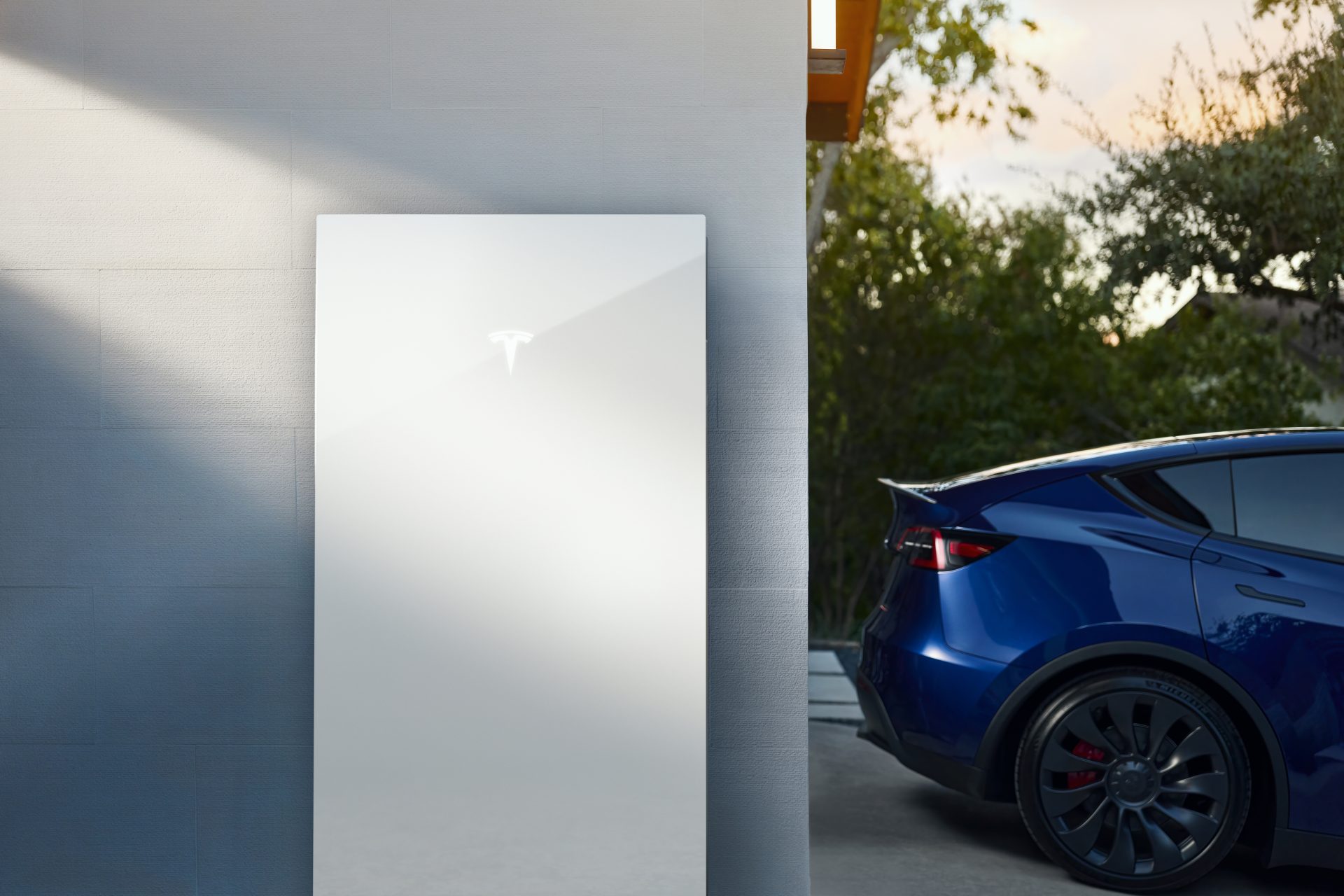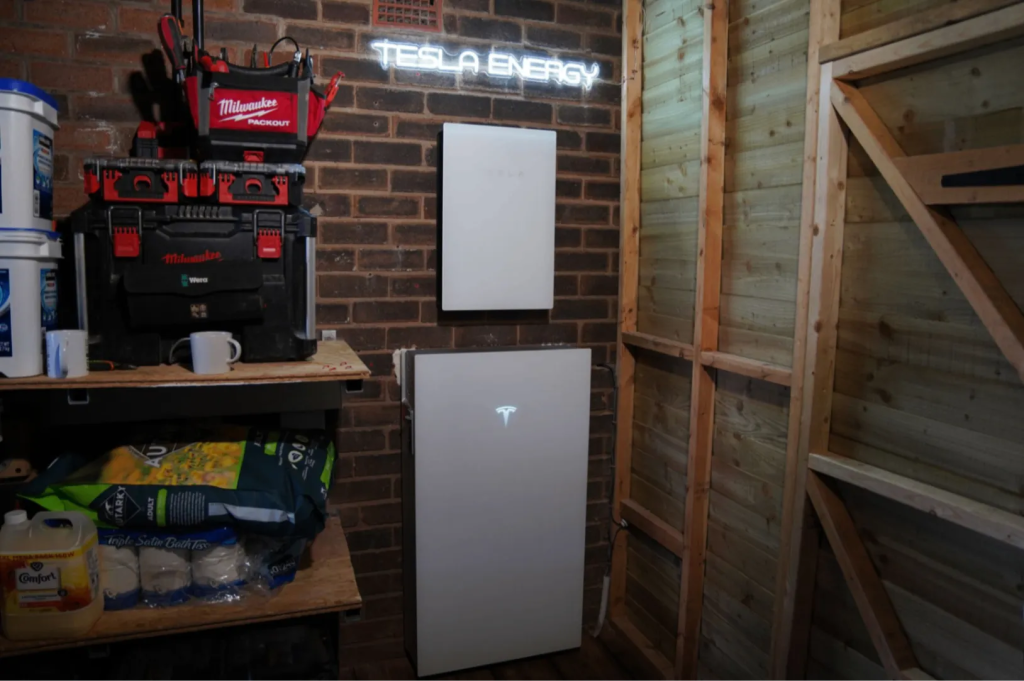The Tesla Powerwall is a rechargeable lithium-ion battery that can be installed in your home to store harvested solar energy, energy from the national grid, or both.
While Tesla is the market leader in solar/home storage batteries because of its high energy capacity, high quality, and beautifully designed products, it is one of the more expensive options available.
So is the Tesla Powerwall worth the extra cost? And how do other alternatives on the market compare?
Let’s find out…
What does the Telsa Powerwall cost?
The Tesla Powerwall battery costs around £6,600 with an upfront deposit needed of £400. However, the true cost of the Powerwall is much higher.
You will also need the supporting hardware, which costs £1,700.
Then add on the cost of the installation, which can cost anywhere between £800-£2,800, taking the cost to between £9,100- £11,100.
It is recommended you use an accredited Tesla installer, and you will need permission from the National Grid before installation (however, if you do opt for a reputable installer, they will typically handle the application process for you).
You may need some electrical work in your home to support where the Powerwall will be installed. Be prepared that this may add extra costs to the final bill.
Important tip: If you want to avoid upsells and confusing packages, we would recommend using a provider that offers a fixed price quote that will provide you with an upfront cost that will not change. Heatable is one such Tesla Premium Installer that offers this.
Get a free quote:
- It’s free, easy, and without obligation
- Compare quotes & get the best prices
- Save up to £660 per year

What models of the Tesla Powerwall are on the market?
The latest version of the Powerwall is the Tesla Powerwall 3, which launched in the UK in June 2024.
Tesla Powerwall 2 vs Powerwall 3
In the table below, we have compared the key features of both generations of the Tesla Powerwall:
| Features: | Tesla Powerwall 3 | Tesla Powerwall 2 |
|---|---|---|
| Usable Capacity | 13.5 kWh | 13.5 kWh |
| How many can I install? | Up to 4 units (54 kWh) | Up to 10 units (135 kWh) |
| Round-trip efficiency | 90% | 89% |
| Depth of discharge | 100% | 100% |
| Continuous power output | 3.68-11.5 kW | 5-7.2 kW |
| AC- or DC-coupled? | Options for both (inbuilt hybrid solar inverter) | AC |
How Do the Tesla 2 & 3 Differ?
As a result, the Tesla Powerwall 2 is likely to be discontinued in the near future.

Image showing the latest Tesla Powerwall 3 model.
The Tesla Powerwall first hit the market in 2015, closely followed by the Powerwall 2 in 2016, which was then updated in November 2020.
The next version, the Powerwall+, followed in April of 2021, which is a combination of the Powerwall 2, a Backup Gateway, and a solar inverter.
The Backup Gateway is a system that works with the Powerwall to prevent your home from being affected by power cuts.
It will detect power outages and automatically power your home with the Powerwall battery.
Powerwall 2 vs Powerwall 3
How does the latest Powerwall model compare to the new version?
The major upgrade from the Powerwall 2 to the Powerwall 3 is its all-in-one (hybrid) system design, featuring a built-in solar inverter.
This major upgrade removes the need for a separate inverter, which was necessary with the AC battery design of the Powerwall 2.
Additionally, the Powerwall 3 can deliver up to 11,000 watts of continuous power, more than double the capacity of the old version.
Below, we will explore the most important metrics of the latest Powerwall and how things have changed, most often for the better:
Tesla Powerwall’s Capacity
The latest version of the Tesla Powerwall 3 boasts a capacity of 13.5 kWh.
You have the option of 5.8 kW of continuous power or short 10-second bursts of 10 kw.
This substantial capacity makes it perfect for larger households, households that want to live off the grid, or households with electric cars that wish to use solar energy to charge them.
Tesla Powerwall’s Dimensions
The Tesla Powerwall 3’s dimensions are 1,150 x 753 x 147 mm.
It can be floor or wall-mounted and can be placed both inside and outside.
It is also possible to stack up to 10 Powerwalls together, allowing for scalable energy storage solutions tailored to your needs.
Tesla Powerwall’s Warranty
Tesla offers a 10-year warranty on the Powerwall 3.
This includes an unlimited number of cycles and a guarantee that it will still work at a minimum of 80% capacity.
This means if your Powerwall drops below 80% of its original capacity in 10 years, you will qualify for a replacement.

Image credit: Heatable.co.uk
Alternatives to the Telsa Powerwall
While there is currently no competitor offering what the Tesla Powerwall does, these are some other battery storage options that may be worth mentioning:
Enphase Encharge
3.4-10.5 kW capacity, 3.84 kW continuous power. £4,000- £8,000+
Pros to the Enphase battery include different sizes being available, which the Tesla does not offer, and it can detect and report power outages.
However, its price is very similar to the Powerwall despite having a smaller capacity.
Generac PWRcell
9-18 kW Capacity 3.4-6.7 kW continuous power £7,400+
Pros include one of the highest capacities on the market, as well as a range of sizes.
The downsides are that the price is still high, and its warranty is based on the amount of energy storage and not the number of years.
LG CHEM RESU 10h
9.3 kW capacity, 5 kW continuous power, £5,800
Claims to have a lifespan of 4,000 cycles and has battery cells layered in a unique pattern, which they claim prevents failures and provides long-term reliability.
BYD Battery-Box HV
5.1-12.8 kW capacity 5.1-12.8 kW continuous power £3,300+
This battery boasts a high capacity and high continuous power for a much lower price tag. It comes in multiple sizes.
The only downside is a lower warranty.
Powervault 3
8.2 kW capacity, 4.0 kW continuous power, £4,100+
Voted Best for off-the-grid living by the Eco Experts, this battery is much more affordable with a high capacity.
Benefits to the Telsa Powerwall 3
As well as storing the power generated from your solar panels, there are several other benefits to choosing the Powerwall 3:
Liquid Thermal Control System
This system controls the Powerwall’s internal temperature to ensure top performance through all seasons and climates.
Power the Battery with Multiple Sources
You can charge the battery from other sources if needed, such as during the night when electricity is cheaper.
This stored electricity can power your home when your solar panels are producing less energy, like on a cloudy winter’s day, potentially meaning you may never have to pay the full price for energy again.
Provides Backup Energy
With the addition of the Backup Gateway, the Powerwall 3 can detect power outages and automatically become your home’s energy source. This means you’ll never have to deal with power cuts again.
Other Advantages of the Tesla Powerwall 3:
- Sell Energy Back to Your Supplier: You can sell excess energy back to your energy supplier, getting a return on your investment.
- Completely Automated: The system is fully automated, requiring no maintenance from you.
- Flexible Installation: It can be installed inside or outside, and you can choose from wall or floor-mounted installation to fit perfectly in your home.
- Sleek Design: The Powerwall 3 features an attractive black design, making it an aesthetically pleasing addition to your home.
- Safety: It’s safe to have around children and pets, with no visible wires or areas that can overheat.
- Scalability: You can stack up to 10 batteries together for increased capacity.
- Built-in DC-AC Inverter: Works seamlessly with your solar panels.
- Tesla App Integration: The Powerwall 3 connects to the Tesla App, which monitors your home’s energy use and sends alerts for weather forecasts and energy usage estimations.
- Property Value: Installing a Powerwall 3 can increase the value of your property.
Related solar guides:
- How many solar panels do you need?
- Smart Export Guarantee
- Can you install solar panels in a conservation area?
- Best 4kw solar system with battery storage
- Sunshine hours map UK
- Best Solar Panels
- Solar panel output calculator
Is the Powerwall right for your home?
For most households, a battery with 5-10 kWh is large enough to power their home in the evenings and overnight.
With a capacity of 14 kWh, it is likely that a smaller, less expensive battery will be enough for your home.
The Powerwall, as stated above, is worth it if your energy use is higher than normal.
This could be because you charge an electric car, or you want to live as off the grid as possible.
For anyone with solar panels and potentially anyone on certain tariffs who wants to store cheaper off-peak energy, the Powerwall will save you money.

Do I need a solar battery if I have solar panels?
It’s not a necessity to have a battery if you have solar panels; however, installing a solar battery like the Tesla Powerwall means you can store electricity for when the sun is not shining, like in the evenings.
This allows the use of the solar energy you generated during daylight hours overnight, dramatically reducing the amount of electricity you may need to draw from your supplier.
It is also possible to charge the Tesla Powerwall from other sources, for example, charging it overnight when electricity from the grid is cheaper, e.g. during off-peak hours (depending on your tariff).
Help with the cost of the Tesla Powerwall
Installing a battery like the Powerwall on top of the cost of installing solar panels is expensive.
However, there are ways to help with the cost, including the following:
The Smart Export Guarantee (SEG)
A system that can earn you money by exporting your stored energy back onto the grid.
You’ll need to check if your energy supply does this; if so, 4-6/kWh is a good rate.
0% VAT on your solar panels and Powerwall
You will only qualify for the zero VAT on solar panels if you install both at the same time with the same company, but it could save you pennies if you plan on doing this.·
If you’re in Scotland, you could benefit from solar energy grants.
The Home Energy Scotland Loan means you can get up to £6000 and £5000 interest-free when you install panels and batteries.
